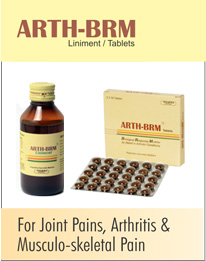Products

Arth - Brm - Liniment/Tablets
Therapeutic Category : Anti-arthritic Biological Response Modifier
Therapeutic Category : Anti-arthritic Biological Response Modifier
Actions
Boswellic acids & oleoresin from Boswellia serrata, Ellagic acid, gallic acid, chebulinic acid, bellericanin, ß-sitosterol & flavanoids from Triphala, Phenolic gingerols from Zingiber officinale and Curcuminoids from
Curcuma longa are the principle active / marker phytochemicals in Arth-BRM tablets. These multiple phytochemicals synergize to “switch-off” inflammatory & degenerative processes in musculoskeletal and synovial
microenvironment by acting at numerous aspects of the inflammatory process.
Similarly, the botanicals and volatile oils in Arth-BRM liniment provide instant relief in musco-skeletal conditions due to local analgesic and counter-irritant effects.
Similarly, the botanicals and volatile oils in Arth-BRM liniment provide instant relief in musco-skeletal conditions due to local analgesic and counter-irritant effects.
Indications
- Joint pain (Sandhishul)
- Osteoarthropathy / Musculo-skeletal pain (Sandhigata vata)
- Stiffness of joints (Sandhigraha)
- Arthritis (Sandhi sotha)
- Gout (Vatarakta)
- Lumbago (Prsthna sula)



